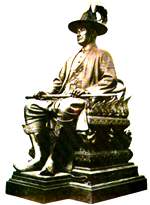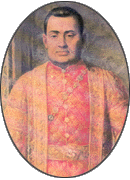Wat Pra Chetupon
Historical study of watpho
Bangkok, the capital of the Kingdom of Thailand, is otherwise known as
Krung Thep or the City of Angels. The heart of Bangkok is in the so-called Ko
Rattanakosin area where this ancient city was first constructed. Much of its
historical and cultural heritage was accumulated in this area, and subsequent
generations have proudly applied their inherited knowledge for daily life and
careers guide-lines through to present time.
 Wat Pho, the official name
being Wat Phra Chetuphon Vimolmangklararm Rajwaramahaviharn , is a first grade
royal monastery, regarded as the most important one during the reign of King
Rama I of the Chakri Dynasty. The importance of this is due to the King having
managed the restoration of Wat Phodharam, an old monastery from the Ayudhya
period, and had it re-established as a royal monastery located near the Grand
Palace. Some ashes of King Rama I were also kept under the pedestal of the
principal Buddha image known as Phra Buddha Deva Patimakorn in the main chapel.
The monastery is located on an area of 20 acres to the south of the Grand
Palace, with Thai Wang road in the north, Sanam Chai road in the east,
Setthakan road in the south and Maharat road in the west. Separated by a tall
white wall on Chetuphon road, the monastery has two main quarters : the sacred
(or a chapel section = Buddhavas) and the residential (or the monk's living
section = Sangghavas). Wat Pho, the official name
being Wat Phra Chetuphon Vimolmangklararm Rajwaramahaviharn , is a first grade
royal monastery, regarded as the most important one during the reign of King
Rama I of the Chakri Dynasty. The importance of this is due to the King having
managed the restoration of Wat Phodharam, an old monastery from the Ayudhya
period, and had it re-established as a royal monastery located near the Grand
Palace. Some ashes of King Rama I were also kept under the pedestal of the
principal Buddha image known as Phra Buddha Deva Patimakorn in the main chapel.
The monastery is located on an area of 20 acres to the south of the Grand
Palace, with Thai Wang road in the north, Sanam Chai road in the east,
Setthakan road in the south and Maharat road in the west. Separated by a tall
white wall on Chetuphon road, the monastery has two main quarters : the sacred
(or a chapel section = Buddhavas) and the residential (or the monk's living
section = Sangghavas).
 It is said in a stone inscription
that, after moving to the Grand Palace, King Phra Buddha Yod Fa The Great (King
Rama I) recognized that there were 2 old temples along both sides of the Grand
Palace : Wat Salak (Wat Mahatart) in the north, and Wat Phodharam in the south.
He ordered his noblemen from the department of the Ten Crafts to restore Wat
Phodharam in 1788. This first restoration took 7 years 5 months and 28 days.
Then there was a celebration in 1801 and the Royal named it “Wat Phra Chetuphon
Vimolmangklavas”, which was changed to “ Wat Phra Chetuphon Vimolmangklararm
during the reign of King Rama IV. The great restoration, having taken 16 years
and 7 months, was done during the reign of King Rama III, by extending both the
South Vihara and West Vihara where the large reclining Buddha image is kept,
the Missakawan Park, Phra Mondob (Library Hall) and teaching-learning hall as
they are of today. Although there was another restoration before the Bangkok
Bicentennial Celebration in 1982, no more other major work has been done on the
monastery, except for some minor repairs. It is said in a stone inscription
that, after moving to the Grand Palace, King Phra Buddha Yod Fa The Great (King
Rama I) recognized that there were 2 old temples along both sides of the Grand
Palace : Wat Salak (Wat Mahatart) in the north, and Wat Phodharam in the south.
He ordered his noblemen from the department of the Ten Crafts to restore Wat
Phodharam in 1788. This first restoration took 7 years 5 months and 28 days.
Then there was a celebration in 1801 and the Royal named it “Wat Phra Chetuphon
Vimolmangklavas”, which was changed to “ Wat Phra Chetuphon Vimolmangklararm
during the reign of King Rama IV. The great restoration, having taken 16 years
and 7 months, was done during the reign of King Rama III, by extending both the
South Vihara and West Vihara where the large reclining Buddha image is kept,
the Missakawan Park, Phra Mondob (Library Hall) and teaching-learning hall as
they are of today. Although there was another restoration before the Bangkok
Bicentennial Celebration in 1982, no more other major work has been done on the
monastery, except for some minor repairs.
 From the by-paths of history in the
great restoration during King Rama I and King Rama III, it is said that all
best craftsmen from the Royal Palace, outside the palace, all art work
specialists, and the monks devoted themselves in creating this elaborately
decorated monastery. This was done to fulfill the King's ambition of using this
Wat as the centre of Thai arts and knowledge, where descendants can study
indefinitely. From the by-paths of history in the
great restoration during King Rama I and King Rama III, it is said that all
best craftsmen from the Royal Palace, outside the palace, all art work
specialists, and the monks devoted themselves in creating this elaborately
decorated monastery. This was done to fulfill the King's ambition of using this
Wat as the centre of Thai arts and knowledge, where descendants can study
indefinitely.
In “ The Ubosot of Wat Pho “ book, Chakrabhand Posayakrit who is a famous
artist of Thailand said on October 10, 1999 “The fine arts in Wat Pho are a
bounteous wealth of knowledge. These enormously valuable resources can
stimulate and enhance youthful enthusiasm for attaining artistic excellence and
distinction.”
Wat Pho is an important landmark in the Rattanakosin area. Visitors can enjoy
the beautiful Buddhist fine arts and the existing Thai intellect which has
descended from ancient times, taken as immortal careers knowledge.
Tourist information WatPho
WAT Pho is located on Sanam Chai road and Maharaj road next to the Grand
Palace. It is open daily between 08:00 - 17:00 hrs, with an admission fee of 20
baht. Tourists must be in polite dress, no shorts, although trousers are
permitted.
Thai Traditional MedicalScience School and Body Massage
Thai Traditional MedicalScience School and Body Massage. Thai
traditional medical science can be found throughout all of the Thai community,
with certain cures from herbs and other ingredients. In the old days there were
2 types of doctors: a royal doctor and a local one. At the start of the
Rattanakosin period, King Rama III appointed a royal doctor, Phraya Bamroer
Rajaphat, as the chief of the doctors to inscribe medical texts on pieces of
slate and framed them on columns of the cloisters around the Pra Maha Chedis
and in pavilions or Sala Rai.
In 1856 King Rama V appointed his royal doctors to translate the great edition
of Pali-Sanskrit medical texts into a Thai version indexing the books as
Medical Science Textbook (Royal Edition); and another on body massage known as
Massage Hand book – Royal Edition. On 30 th May, 1962, a council of ancient
medical science doctors were approved by Ministry of Health to found Wat Phra
Chetuphon Thai Traditional Medical Science School (Wat Pho) for Thai
traditioanl medical science and body massage only. This school is located at 2
Sala Rai in the East.
There are 2 kinds of Thai traditional massage science: one is following the
contorted hermit postures; and another is herbal massage .
|
|
|
|